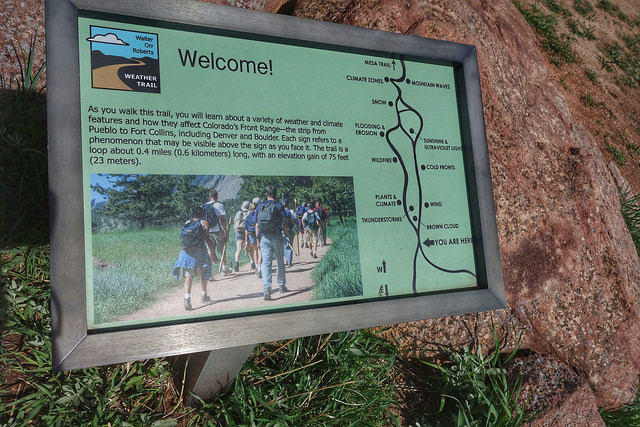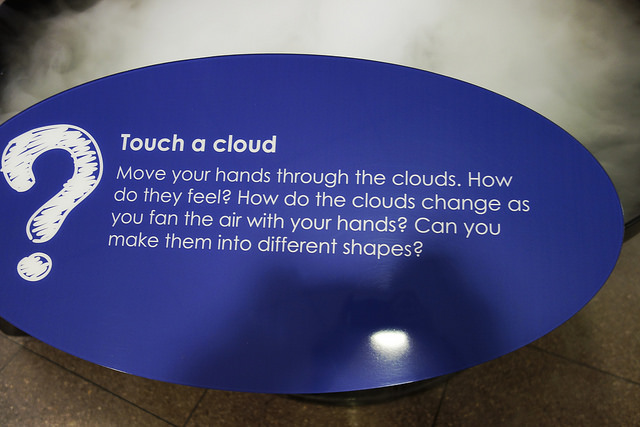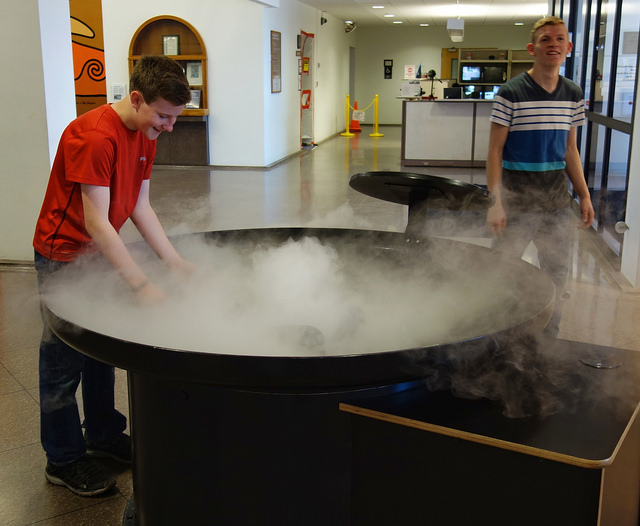As I type, the wind is chasing clouds across a pale blue sky and making the boughs of the Scotch Pine and serviceberry trees outside my window bounce and sway. Now, here’s something a bit weird: Until recently, I don’t know why, I didn’t think of weather when I thought of nature. The Scotch Pine was nature. The serviceberry was nature. But not the wind, the clouds, the sun… A chance visit to a very special place changed that outlook.
While in Boulder, Colorado for my daughter’s graduation, I was encouraged to visit “NCAR” for the incredible view of the city and the wonderful hiking trails. The morning was clear and sunny. The temperature was cool, though forecast to rise quickly. So, I laced up my boots, slathered on the sunscreen and headed out. I was not disappointed on either account; the trails were beautiful and so was the view.
What I didn’t realize until I got there was that NCAR stands for the National Center for Atmospheric Research and that there was plenty more on that hillside besides a trailhead and a view.

weather trail welcome sign.
A short, level, 0.4-mile hiking loop behind the enormous building, which we’ll get to later, includes interpretive signs themed around weather. The Walter Orr Roberts Weather Trail was so named in honor of the American astronomer and astrophysicist, educator and philanthropist who was the founding director of NCAR and the first president of the University Corporation for Atmospheric Research which runs NCAR. Inspired by a similar trail in Switzerland, this interpretive trail about weather which opened in 1997 is believed to be the first (and only?) trail of its kind in North America. Eleven signs inform hikers about snow, flooding and erosion, thunderstorms, wind, cold fronts, and more. According to the welcome sign, the interpretation is placed strategically so that visitors could, under the right conditions, observe the topic of the sign in real time.
The Weather Trail connects via a spur to the Mesa Trail, a seven-mile end-to-end hike which treats the hiker to incredible views and a variety of habitats from high desert to deep, old growth forest, so the literature says. Sadly, I was not in good enough shape, nor did I have the time to do this entire trail. Maybe someday. The short segment of the Mesa Trail that I did hike was beautiful.

view along the trail
After the hike, I was grateful the huge NCAR building was open, primarily for the restrooms. I really did not expect to find room after room of hands-on interpretive displays, all available to the public free of charge. The staff at Audubon is in the beginning phase of designing new exhibits, so I explored NCAR’s exhibits with that in mind snapping many pictures along the way. What delighted me most about the displays was that they were more than hands-on; they were minds-on. They went beyond presenting information and invited you to interact, to think, and to talk with fellow visitors.

touch a cloud sign
One of the displays titled “Touch a Cloud” was a large bowl that magically produced a never-ending supply of water vapor. The sign said, “Move your hands through the clouds. How do they feel? How do the clouds change as you fan the air with your hands? Can you make them into different shapes?” Every visitor who interacted with this display had a huge smile of pure delight. There were more of these hands-on, minds-on displays that taught about microbursts, lightning, and wind. Some concepts, like the cloud, were simple. Others were more complex, like the multi-armed pendulum whose random patterns of motion were a metaphor for chaotic weather systems and used to explain the difficulty of accurate forecasting.
Several of the displays encouraged visitors to think about climate change from the perspective of human causes, as well as what we must do in reaction to it. Some displays looked at weather through a cultural lens. And there was humor. Benjamin Franklin’s portrait was displayed next to this quote: “Some people are weatherwise, and most are otherwise.”
Strangely, I never thought of weather as part of nature before. Weather was weather and nature was plants, animals and landscapes. Since visiting NCAR, I see weather differently – as an integral part of the natural world. I notice the weather more, as well as its effects on all it touches. If you get to Boulder, I strongly encourage a visit to the National Center for Atmospheric Research – both for the hiking and for the museum.

touching a cloud
People like to praise nice weather and bemoan bad weather. Have you ever considered what certain atmospheric conditions could do for you? On Saturday, June 17, you can attend a program at ACNC titled “What Can Wind and Solar Energy Do for You?” presented by Dave Moller, who has been designing and installing wind and solar systems for homes, businesses, and small farms for over ten years. The cost of the program is $8 per person, or $6 for Nature Center members. Bring your most recent electric bill. You can pre-register at auduboncnc.org. Registration is not required, however, so feel free to drop in at 1:00 p.m.
Audubon Community Nature Center builds and nurtures connections between people and nature. It is located at 1600 Riverside Road, one quarter mile east of Route 62 between Jamestown, New York and Warren, Pennsylvania. For more information, call (716) 569-2345 or visit auduboncnc.org.
Jennifer Schlick is program director at ACNC.


Recent Comments